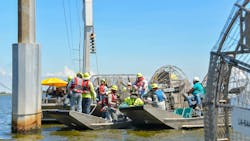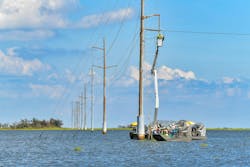Before the first hurricane of the season even makes landfall, electric utilities strengthen their systems, practice response strategies and create a proactive approach to restoration. In a typical year, about seven hurricanes, including three major ones, hit the Atlantic and Gulf of Mexico. Last year, the Atlantic hurricane season encompassed 11 hurricanes, including three major ones, some of which have directly impacted Entergy’s service territory.
Over the last 25 years, the Edison Electric Institute (EEI) has given New Orleans-headquartered Entergy 48 Emergency Response Awards for the way it tackles storm outage recovery and assistance. Entergy’s approach may help other utilities across North America consider different priorities for restoration or double-down on the things they are already pursuing.
With the uptick in storm activity, Entergy and its contractors were busier than ever restoring power for customers and neighboring power companies. To mitigate the increased strength and frequency of severe weather hitting its service territory, Entergy, among other things, continues building a more resilient grid.
“Resilience is not only the strength of the system but also how quickly we recover and restore power to our customers following severe weather,” said Dakin DuBroc, vice president of incident response for Entergy.
Looking Back on the 2024 Hurricanes
Among last year’s challenges for Entergy were Hurricanes Beryl and Francine. Beryl made landfall on July 8, 2024, as a Category 1 hurricane near Matagorda, Texas, with maximum sustained winds of 85 mph and 97 mph gusts. Beryl also notched the record for the most tornadoes produced by a single storm in the region.
“Within five days, we restored power to approximately 90 percent of customers who could safely receive power,” DuBroc said.
Francine, a Category 2 storm, made landfall in Terrebonne Parish, Louisiana, on September 11, 2024, with sustained winds of about 100 mph. After landfall, the center of the storm moved northward into Mississippi. Service was disrupted for about 316,000 customers, but within four days, Entergy restored 100 percent of its customers who could safely receive power.
According to DuBroc, the speed with which restoration happened during Beryl and Francine is partly attributable to resilience investments like constructing raised substations, undergrounding feeders where possible and hardening distribution poles.
As Francine cut across the eastern portion of Louisiana, 437 poles Entergy recently installed as part of its Entergy Future Ready resilience strategy sustained zero damage. In the wake of Francine, customers on Grand Isle, Louisiana, which extends like a finger into the Gulf of Mexico, saw little to no power outages, which is attributed to upgrades made after Hurricane Ida in 2021, DuBroc said,
During Beryl, which affected Texas’ Bolivar Peninsula, Entergy reported no damage to new poles installed in this location as part of its resiliency effort. A new substation on the peninsula and another under construction are elevated, and neither sustained damage from wind nor storm surge, DuBroc said. These measures are part of Entergy’s effort to increase the wind standard at which the utility builds new equipment across its transmission and distribution system.
Changes in the Utility-Contractor Relationship
Many utility contractors and their trade allies have evolved from “chasing storm work” to operating in a way that mirrors storm-ready utilities like Entergy, said Mike Zappone, chief operating officer at Tempest Energy, which delivers storm response services for utilities across the United States and Canada.
Zappone said that contractors must continually develop their skills and know-how while assessing qualifications via resources like ISNetworld. Utility professionals say contractors who stand out are, in part, the ones embracing technology and at the forefront of innovation. An example of that could be developing a cloud-based health, safety and environmental orientation tool or a mobile app to reduce the time to confirm the availability of storm restoration resources.
“Establishing objectives from the outset to consistently communicate with the public, regulators and local, state and federal officials helps everyone know the extent of damage and when they can expect power to be restored,” Zappone said.
Making contract crews feel safe and familiar with processes requires technology, usually in multiple languages whether they are working on overhead line distribution, vegetation management or other disciplines, Zappone said.
“Contractors have to think like the utilities they work for,” said Zappone, who retired from Eversource before joining Tempest Energy. “If you’re going to work and drive tens of thousands of hours and miles on a system without incident, a contractor has to leverage technology to get in lock step with a utility.”
Outlining Four Tactics for Better Restoration
When asked what utilities planning for major events in other parts of North America can learn from the 2024 hurricane season, DuBroc and Zappone offered the following.
1. Make safety job one.
Entergy’s emergency action plan protects workers, contractors and the public by preparing for and preventing the risks with downed power lines and restoration. The plan includes provisions for only qualified personnel providing oversight to crews, heat-stress mitigation and limiting the number of workers any lead can effectively and efficiently oversee.
Tempest Energy, for example, worked 81,000 hours for Entergy without a safety or environmental incident in 2023, which led to winning the utility’s 2024 Storm Response Award. Zappone said part of why that happened was anticipating what the incident response team needed while balancing a sense of urgency with safety.
“Any third parties used during restoration efforts are trained in our expectations and requirements before beginning work,” DuBroc said. “We are monitoring and managing workers’ potential fatigue, which includes restrictions on how many hours they work each day.”
The payoff: For Beryl, Entergy’s native and contract crews worked about 341,000 hours with no serious injuries. During Francine, crews worked more than 550,000 hours without a single severe injury.
2. Prepare, prevent and predict.
In advance of Francine, Entergy’s teams patrolled more than 1,200 miles, trimmed overhanging tree limbs at about 1,400 locations and removed 340 trees that threatened electrical infrastructure, DuBroc said. The work helped reduce outages from vegetation contacting electrical infrastructure and mitigated the potential for trees and limbs falling and blocking access to assets. Entergy also pre-staged crews and equipment as close as it safely could in areas the utility expected the hurricane would impact, which expedited restoration.
In addition, Entergy continuously improves its processes to have the right resources in place at the right time for restoration. Hurricanes Francine and Beryl gave Entergy the opportunity to launch an enhanced resource and logistics planning tool. With the tool, the utility collaborated simultaneously across its transmission, distribution, supply chain and incident response groups to prepare prior to each storm’s landfall. Entergy also tapped technology called Storm-DEPART, shorthand for the Damage Estimation, Prediction and Resource Tool.
“Storm-DEPART uses national hurricane forecast data and Entergy asset data to provide predictions for distribution and transmission assets, which helps determine resources,” DuBroc said.
3. Apply new technologies for assessment.
Entergy also optimized how it assessed damage to its system by using a new application dubbed the Damage Assessment Collection Tool, or DACT. With the tool, assessors in the field cataloged things like broken poles and damaged transformers in real time and digitally transferred the information to the restoration planning team. Assessors accessed online maps in DACT to relay the exact location of damage. Both native and non-native crews use DACT as part of restoration.
Zappone said smaller utilities may not have the workforce to quickly assess storm damage. Some rely on paper maps and highlighters to report and track restoration efforts.
“This is an area where contractors, with experienced damage assessors and managers, can be an efficient resource to augment or even lead a smaller utility’s storm center operations,” Zappone said. “Contractors and vendors are also developing technology to replace manual damage assessment processes, particularly for smaller municipalities and cooperatives.”
4. Build new lines of communication.
Establishing community partnerships between government and incident commanders before a storm is a critical opportunity to set priorities for re-energizing assets. Through meetings with utilities and contractors, government officials can highlight the importance of what might otherwise be a low-visibility location like a water or sewage treatment plant.
By keeping an eye on people who are changing roles, whether at a utility, government agency or contractor, an opportunity arises to educate new contacts. By understanding the overall storm plan, someone who is otherwise new to his or her position can then effectively contribute when a storm strikes.
“Building and maintaining these connections before a major outage ultimately means smoother communication because people know one another and the priorities; that helps with faster restoration of services for constituents,” Zappone said. “Don’t let the worst time be the first time you discuss plans, priorities and expectations.”
Expediting restoration ultimately “requires the right processes, electronic tools and trained personnel in place well in advance of a storm,” DuBroc said.
About the Author
Bill Perry
Bill Perry ([email protected]) is a New York-based freelance writer who has covered the utility, manufacturing and aerospace and defense industries for more than 20 years.


